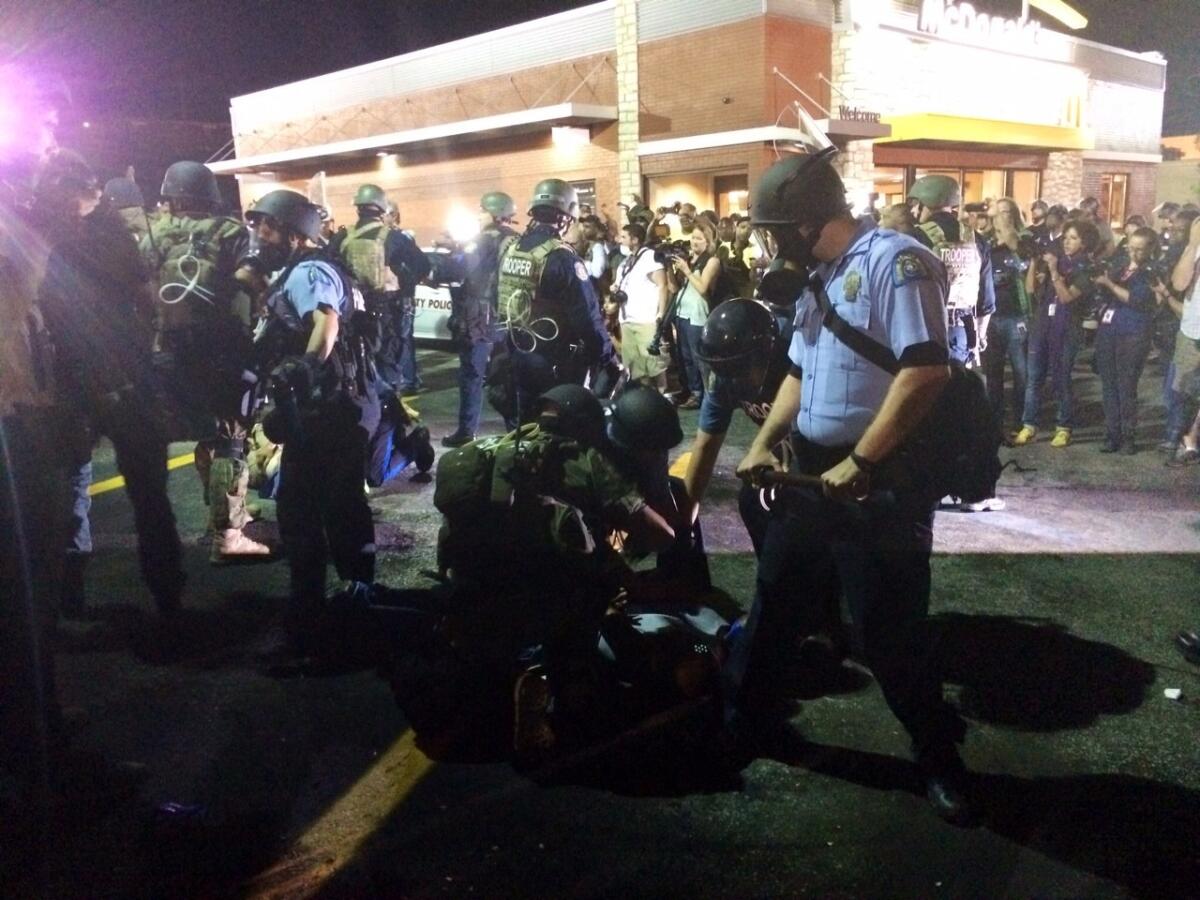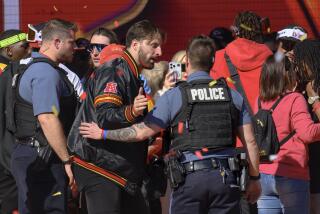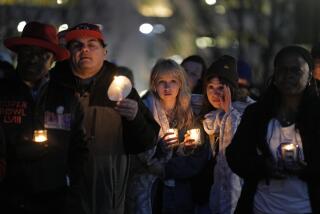Ferguson turns tense around midnight; protesters step in to keep peace

- Share via
Reporting from Ferguson, Mo. — After a night of virtual calm on Ferguson streets, protests over the Aug. 9 police killing of an unarmed black man turned tense shortly before midnight Tuesday when someone threw a bottle and police swarmed to make an arrest.
The night appeared on the verge of spinning out of control until some protesters stepped in. They linked arms and formed a line to separate police from possible troublemakers.
Matt Mendoza, 29, of St. Louis, said he was among them.
“It’s what I can do to help with the situation,” he said as protesters backed off. “From what I’m seeing, police are instigating when they break off and start running, creating utter chaos. It’s better to just let it go.”
Shortly before the trouble began, protest leaders had stopped marching to hold a prayer and to try to get demonstrators to go home and return for a protest outside the county justice building in the morning.
After the prayer, however, the demonstrators lingered.
Suddenly the situation turned confusing. Apparently after a bottle was thrown, police made a movement and young men in the crowd started running. After police made an arrest, demonstrators appeared to throw bottles, and police deployed what sounded like noisemakers.
The situation remained fluid on West Florissant Avenue. About 1:45 a.m., police in riot gear searched, handcuffed and sat five individuals in the middle of the street beside a military-style vehicle.
Highway Patrol Capt. Ron Johnson, the officer in charge of the police presence, was out with troopers in the crowd at the McDonald’s in the protest area. Johnson wore a bulletproof vest but not a helmet.
In the nearly two weeks since Brown’s death, the demonstrations have turned unruly after dark. On Monday night and into Tuesday morning, police made 78 arrests, confiscating at least two guns and a Molotov cocktail.
Johnson has accused outsiders of stirring up trouble in the darkness. At least 14 of those arrested were from outside Missouri.
One of them, Carl Dix, denied that outsiders were troublemakers. “There are no outsiders in the struggle against injustice and oppression,” said Dix, from Brooklyn, N.Y. The locals he met, he said, “have wanted to hug me.”
Tuesday night, dozens of people were marching up and down the sidewalk and, at least for the moment, the atmosphere was calm.
The Rev. Robert White of the Peace of Mind Church in St. Louis was among the older community leaders trying to keep the peace.
“The police are out here to protect us,” he told CNN. White urged protesters to “give Ferguson a break” and let businesses get back on their feet.
“If we could end tonight without one person getting shot, that would be a real blessing,” he said.
Missouri Atty. Gen. Chris Koster briefly came to the streets to address demonstrators. His spokeswoman issued a statement in his name voicing confidence in St. Louis County prosecutor Robert McCulloch.
“It is my understanding he has placed the matter in the hands of two highly experienced prosecutors, one of whom is African American,” Koster said in the statement. “I trust in their ability to diligently and fairly present the evidence in this case.”
A St. Louis County grand jury was expected to begin hearing evidence Wednesday. Meantime, federal officials are conducting a parallel civil rights investigation.
A group of African American attorneys has called on McCulloch to remove himself from the case, accusing him of bias. He has declined to do so.
Gov. Jay Nixon said he would not call on McCulloch to back out. In an evening statement, the Democratic governor said: “From the outset, I have been clear about the need to have a vigorous prosecution of this case, and that includes minimizing any potential legal uncertainty. I am not asking St. Louis County prosecutor Bob McCullough to recuse himself from this case.
“There is a well-established process by which a prosecutor can recuse” himself, Nixon continued. “Departing from this established process could unnecessarily inject legal uncertainty into this matter and potentially jeopardize the prosecution.”
Earlier Tuesday, U.S. Atty. Gen. Eric H. Holder Jr. said federal investigators had interviewed hundreds of people in connection with the Brown killing. A federal autopsy performed at Holder’s orders showed that Brown was shot six times, officials said. Holder is to visit Ferguson on Wednesday.
In an op-ed piece posted by the St. Louis Post-Dispatch titled “A Message to the People of Ferguson,” Holder strongly defended his decision to push forward with the civil rights investigation. Local law enforcement officials in Missouri are being accused of not moving fast enough in investigating Brown’s shooting by a white police officer.
“The people of Ferguson can have confidence that the Justice Department intends to learn – in a fair and thorough manner – exactly what happened,” Holder wrote.
“This is my pledge to the people of Ferguson,” he added. “Our investigation into his matter will be full, it will be fair, and it will be independent.”
The attorney general revealed that about 40 FBI agents and some of the Justice Department’s civil rights division’s “most experienced prosecutors have been deployed to lead this process, with the assistance of the United States attorney in St. Louis.”
In Missouri on Wednesday, Holder plans to meet with community leaders, FBI investigators and federal prosecutors, he said, “to receive detailed briefings on the status of the case.”
Holder went on to warn protesters in Ferguson against looting and violence, calling those who engage in such activities a small minority who only “seriously undermine, rather than advance, the cause of justice.” He added, “Violence cannot be condoned.”
Federal law enforcement officials said a U.S. military medical examiner had concluded a federal autopsy of Brown and it showed six gunshot wounds, according to a government source who asked not to be identified. Holder confirmed in his op-ed that the autopsy was complete.
The federal autopsy was the third postmortem to be performed on Brown. The first was performed by the St. Louis County medical examiner, and the second was on behalf of Brown’s family.
The results of the county autopsy have not been made public. The private autopsy, like the federal postmortem, showed six gunshot wounds.
Holder has said that the civil rights investigation will review the county-performed autopsy.
Separately, a group of African American attorneys called for McCulloch to remove himself from the investigation and let the Justice Department take over the case.
At a news conference on the steps of the courthouse in downtown St. Louis, Kendra Howard, leader of the Mound City Bar Assn., said residents of nearby Ferguson and elsewhere were “gravely concerned about the lack of transparency and lack of candor” of McCulloch’s office since Brown’s death.
“Mr. McCulloch has shown that he is emotionally invested in protecting law enforcement, and therefore should immediately step aside and allow the Justice Department to investigate the death,” Howard said.
Ed Magee, spokesman for the county prosecutor’s office, has denied allegations that the office cannot be impartial in the case. McCulloch hopes to begin presenting evidence to the grand jury on Wednesday, depending on the availability of witnesses, Magee said.
McCulloch has been the elected prosecutor in St. Louis County since 1991, reelected every four years by a large majority, most recently on Aug. 5, Magee said. “The residents of St. Louis County have faith in Mr. McCulloch, and he will continue to carry out his duties,” Magee said.
But the delay in releasing details of the shooting, including the name of the police officer involved – Darren Wilson – and the revelation that Brown was shot at least six times, has angered the community and led to allegations of an attempted coverup.
“The only information released has been irrelevant and aggravated a tense situation,” Howard said, alluding to last week’s particularly inflammatory revelation that Brown was a suspect in a robbery that occurred shortly before he was shot.
Ferguson police released the video on Friday -- the same day they released Wilson’s name.
On Tuesday morning, after peaceful protests in Ferguson devolved into the ninth night of unrest, residents gathered to clean up debris from West Florissant Avenue.
Schools remained closed in Ferguson as officials feared for the safety of children who would be walking to and from campuses.
Brown’s parents said they were planning a public memorial for their son on Monday. Michael Brown and Lesley McSpadden said the prosecution of the officer who shot their unarmed son was the only way to bring peace to the streets of Ferguson.
“Justice will bring peace,” McSpadden told the “Today” show’s Matt Lauer.
“We need to keep the focus on Michael Brown Jr.,” Brown’s father said.
The family expects Michael Brown’s body to be released in the next 48 hours, said one of its attorneys, Anthony Gray.
Gray said the parents were devastated by the nightly clashes, which they feel “divert all of the attention from honoring their child and allowing him to begin the process to rest in peace. That’s not how they want him to be remembered. They do not want that to be their son’s legacy.”
Gray, who was out with protesters on West Florissant late Monday, did not fault police, calling their approach “experimental.” He praised the Highway Patrol’s Johnson, chosen by the governor to take over control of the effort from local police last week.
“If we maintained the course we were on before Ron got involved, it would probably be 10 times worse than it is now. Nobody is itching to go back to the security measures they deployed in the beginning,” Gray said, referring to Ferguson police.
Johnson made an effort late Monday to forestall violence, Gray said, holding troopers back from engaging with the crowd of protesters.
“I don’t know if it will work or not. I’m just going to trust that they’re doing what they can to balance the interests that are at work,” Gray said. “What Ron Johnson brought to the street, if he had more of that in the people around him, the situation would be totally different.”
Johnson has called on protesters to stay inside after dark, and although Gray wasn’t sure if that was the solution to the violence, he said the dynamic needed to change.
“Everybody needs to take a break,” Gray said. “We’ve got a big memorial service that needs to be planned,” he said.
Nixon had deployed National Guard troops for the first time overnight Monday to assist the Highway Patrol and St. Louis County police.
A spokesman stressed that guard troops came to Ferguson in a supporting role, not to man the front lines with police, who faced off with protesters in riot gear Monday night, lobbing tear gas and rescuing two gunshot victims.
“They had a limited support role there at the command center, staying there to secure the command center,” spokesman Scott Holste said of the guard.
The deployment came after police complained the night before that protesters had approached the command center, throwing Molotov cocktails and glass bottles, leading police to respond with tear gas and smoke canisters.
During the worst of the clashes, protesters demanded to see Johnson, who had walked the streets with protesters hours earlier pleading for calm.
“Ron Johnson, where are you?” a protester shouted.
Johnson appeared hours later at a command center briefing, where he justified the use of force, saying officers were at risk. He displayed a Molotov cocktail and two guns seized during the melee, which he said included two fires set by vandals at a home and business, and urged legitimate protesters to stay home after dark Tuesday.
“All of these criminals at night that are masking themselves and hiding themselves behind peace, let them come at night so we can identify them, so we can take them away from our community and put them away and make our streets clear,” he said.
Johnson urged protesters to come out only in the daylight so that provocateurs could not hide behind peaceful crowds.
At times, Johnson grew emotional as he defended the actions of law enforcement officers, raising his voice as he described the chaos around them. “We just had officers in the midst of gunfire,” he said.
He vowed to restore calm.
“This nation is watching each and every one of us,” he said. “We’re going to solve this.... We’re going to make this neighborhood whole. We’re going to make this community whole.”
As if to get a little help from a higher power, Johnson had a chaplain open the news briefing with a prayer for peace.
Serrano reported from Washington, Susman and Pearce from Ferguson. Times staff writers Molly Hennessey-Fiske in Ferguson and Lauren Raab in Los Angeles contributed to this report.
Follow @tinasusman, @mattdpearce and @RickSerranoLAT on Twitter for more Ferguson news
More to Read
Sign up for Essential California
The most important California stories and recommendations in your inbox every morning.
You may occasionally receive promotional content from the Los Angeles Times.













